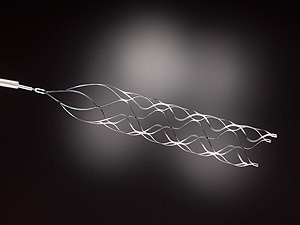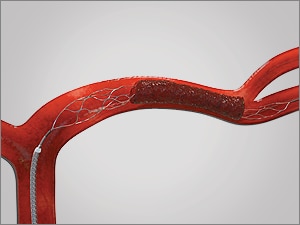August 28, 2012 — Two next-generation mechanical clot retrievers — the Solitaire flow restoration device and the Trevo retriever — work better than the older Merci retriever in stroke patients who are not eligible for or do not respond to thrombolytic therapy, according to the results of 2 randomized comparison trials.
Both of the newer devices were significantly better at restoring blood flow in affected arteries when compared with the Merci device and had similar or better safety profiles, researchers say. These results, from the SWIFT andTREVO 2 trials, were published online August 26 in The Lancet.
"SWIFT and TREVO 2 are major steps forward in the successful treatment of acute ischemic stroke, and pave the way for new treatment options and further validation by additional trials," writes Philip B. Gorelick, MD, MPH, medical director of the Hauenstein Neuroscience Center in Grand Rapids, Michigan, in a linked Comment.
The US Food and Drug Administration (FDA) approved the Merci retriever (Stryker Neurovascular) in 2004, theSolitaire retriever (Covidien/ev3) in March 2012, and the Trevo device (also from Stryker Neurovascular) earlier this month.
The SWIFT Trial
The SWIFT trial, led by Jeffrey L. Saver, MD, director of the University of California Los Angeles (UCLA) Comprehensive Stroke Center, pitted the Solitaire device against the Merci retriever in 113 patients with acute ischemic stroke from 18 centers (17 in the United States).
 |
Dr. Jeffrey L. Saver
|
The Merci retriever is a flexible nitinol wire with distal corkscrew-shaped coil loops with attached filaments. It is deployed distally to the clot through a microcatheter and is used to ensnare and remove the clot into a balloon-guided catheter placed in the cervical internal or vertebral arteries.
The Solitaire retriever is a self-expanding stent retriever. Its "very different shape allows it to gain better traction on the clot," Dr. Saver told Medscape Medical News. "With its columnar mesh, the Solitaire device traps the clot within multiple strut crossings, allowing substantial retrieval grip, and it retains its shape well while pulling the clot out. The Merci, with its helical shape, can lose its shape, unwinding during the pull."
 |
Solitaire FR Retriever (Covidien/ev3)
|
In the SWIFT trial, 58 patients were randomly assigned to the Solitaire group and 55 to the Merci group. Although SWIFT was a noninferiority trial, results demonstrated superiority with the new retriever on several outcomes, Dr. Saver noted when the trial was first presented at the International Stroke Conference in February 2012, and as reported by Medscape Medical News at that time.
In The Lancet paper, researchers report that the primary efficacy outcome — core laboratory–adjudicated successful recanalization with no symptomatic intracranial hemorrhage — was achieved more often in the Solitaire group than in the Merci group (61% vs 24%; difference of 37%; 95% confidence interval [CI], 19 - 53), yielding an odds ratio (OR) of 4.87 (95% CI, 2.14 - 11.10).
In addition, more patients had a good 3-month neurological outcome with Solitaire than with Merci (58% vs 33%; difference of 25%; 95% CI, 6 - 43). The OR was 2.78 (95% CI, 1.25 - 6.22).
Good neurological outcome was defined as a modified Rankin score (mRS) of 2 or less, or equal to the prestroke mRS if the prestroke mRS was greater than 2, or National Institutes of Health Stroke Scale (NIHSS) score improvement of 10 or more points.
Mortality at 90 days was lower in the Solitaire group than in the Merci group (17% vs 38%; OR, 0.34; 95% CI, 0.14 - 0.81).
"A key next step," Dr. Saver told Medscape Medical News, "is to perform a trial of the Solitaire device added to medical therapy versus medical therapy alone in patients identified by brain imaging as still having substantial salvageable brain tissue."
"A positive trial against medical therapy, combined with the SWIFT positive trial against the Merci device, would definitively establish stent retrieval therapy as the best treatment approach," he said.
The TREVO 2 Trial
The Trevo device works in a fashion broadly similar to that of the Solitaire device. The TREVO 2 trial was an open-label, randomized, controlled trial involving 178 patients with large vessel occlusion stroke from 27 sites — all but 1 in the United States. All study participants were ineligible for or refractory to thrombolytic therapy.
 |
Trevo Pro Retriever (Stryker Neurovascular)
|
The primary efficacy endpoint — core laboratory–adjudicated reperfusion to a thrombolysis in cerebral infarction (TICI) grading scale score of 2 or greater — was achieved more often in the Trevo group than in the Merci group (86% vs 60%; OR, 4.22).
"The rates of vessel recanalization in the Trevo group of our trial are amongst the highest published to date," lead investigator Raul G. Nogueira, MD, director of the Neuroendovascular Service and Neurocritical Care Service at Marcus Stroke & Neuroscience Center, Grady Memorial Hospital, in Atlanta, Georgia, told Medscape Medical News.
 |
Dr. Raul G. Nogueira
|
At 90 days, more patients in the Trevo group than in the Merci group had an mRS of 0 to 2 (40% vs 22%; P = .013). Rates of procedure-related events, symptomatic intracranial hemorrhage, and 90-day mortality did not differ between groups.
Initial findings from the TREVO 2 trial were presented at the 2012 European Stroke Conference in May.
"The Trevo device has markedly simplified the thrombectomy procedure, adding greater speed to reperfusion and safety," Dr. Nogueira said. "The ability to offer such treatment should therefore reduce the tremendous burden stroke currently represents to patients, their families, and society," he added.
Answering the Call
In his commentary, Dr. Gorelick notes that the SWIFT and TREVO 2 studies, "although modest in sample size, begin to answer the call for high-level evidence about the efficacy and safety of mechanical clot retrieval devices in acute ischemic stroke."
He says it will be "interesting to learn, on the basis of future nonprimary analyses, whether collateral flow patterns or clot characteristics elucidate propensity for treatment response. Furthermore, the importance of a neuroimaging core laboratory for the determination of revascularization success is emphasized because local investigators might overestimate such success, or record greater detection rates of vessel perforation," Dr. Gorelick notes.
The SWIFT trial was funded by Covidien/ev3. The TREVO 2 trial was funded by Stryker Neurovascular. Several investigators have disclosed relevant financial relationships. A complete list of disclosures is available at the journal Web site. Dr. Gorelick has disclosed that he receives remuneration as co-director of the clinical coordinating center for the DIAS trial, which involves desmoteplase.
Comments
Post a Comment